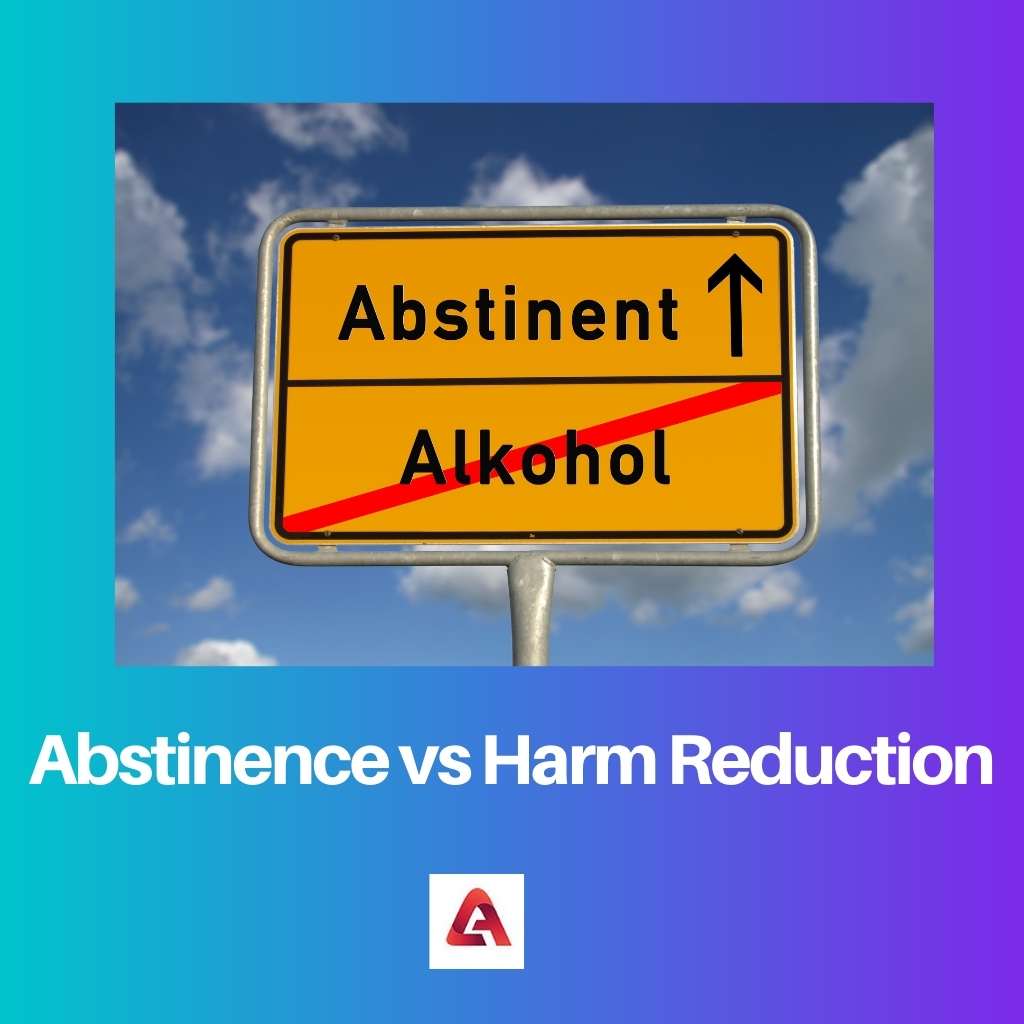There are mainly two widely used strategies for alcohol and drug addiction recovery. These are abstinence and harm reduction, which are widely applicable and useful strategies for defeating addictions.
Both these strategies have some advantages and disadvantages. Several differences between these two strategies make them distinctive from each other.
Key Takeaways
- Abstinence advocates for completely avoiding risky behaviors or substances. Harm reduction focuses on minimizing risks associated with these activities.
- Abstinence-based programs prioritize prevention, while harm reduction strategies emphasize safety and practical interventions.
- Harm reduction recognizes that some individuals may not be ready or able to abstain and offers alternative ways to reduce harm and improve health.
Abstinence vs Harm Reduction
The difference between abstinence and harm reduction is that abstinence is the additional recovery approach that follows the complete termination of drug and alcohol use; on the other hand, harm reduction is the addiction recovery strategy that reduces the harm caused by addictive agents and addiction. Abstinence is more popular compared to harm reduction strategies.

Abstinence is an addiction treatment strategy that terminates the consumption of addictive substances like drugs and alcohol.
In other words, abstinence means completely avoiding any addictive substance for a considerable time.
Suppose a person does not engage themself in any addictive habit at all, either for an extended period or indefinitely. In that case, that person can be called abstaining or abstinent.
Harm reduction is another addiction recovery strategy that aims to reduce the harm caused by addictive agents and addiction.
Harm reduction works by reducing health, social, and economic harm instead of reducing the usage of addictive agents like drugs and alcohol. It focuses on the consequences of addiction and self-accountability.
Comparison Table
| Parameters of Comparison | Abstinence | Harm Reduction |
|---|---|---|
| Definition | Abstinence is the addiction recovery strategy that focuses on withdrawing every addictive agent, like alcohol, drugs, and any other medications. | Abstinence tries to emphasize the roots of addiction by terminating all addictive agents and establishing a long-run recovery. |
| Aim | Harm reduction is less strict than abstinence, and it allows the consumption of addictive agents. | Harm reduction focuses on reducing the consequence of addictive agents and addiction. |
| Strictness | Harm returnless is popularly compared to abstinence as it doesn’t focus on stopping the addiction but focuses on its consequences. | Over the years the use of abstinence has been used widely and gotten popular in rehabilitation centres. |
| Usage | Harm reduction is less popular compared to abstinence as it doesn’t focus on stopping the addiction but focuses on its consequences. | Over the years the use of abstinence has been used widely and gotten popular in rehabilitation centres. |
| Honesty | Harm reduction is less popular compared to abstinence as it doesn’t focus on stopping the addiction but focuses on its consequences. | Harm returnless is popular compared to abstinence as it doesn’t focus on stopping the addiction but focuses on its consequences. |
What is Abstinence?
Abstinence is an addiction recovery practice that restrains the addicted person from indulging in any time of addiction or addictive agents.
It represents exhibiting restraint and self-control when consuming any addictive agents like alcohol or drug, or both. This approach was first introduced in the 1950s by AA or Alcoholics Anonymous through an addiction program.
Currently, most rehabilitation centres use this approach. The abstinence approach focuses on the total termination of addictive agents and addictive behaviour. It consists of ten principles-
- Addiction is a primary and involuntary disease that is diagnosable and describable.
- Addiction is also progressive and chronic disease.
- Addiction can not be cured totally, but it can be dominated.
- The nature of the initial treatment motivation, its absence or presence, can not predict the treatment outcomes.
- The dimensions of addiction treatments can be psychological, spiritual, physical, or social.
- An environment of respect and dignity is required for treating addiction.
- People suffering from substance abuse are considered vulnerable to mood-altering drug abuse, which is seen as chemical dependency.
- Multidisciplinary treatment programs are best for treating chemical dependency.
- A recovered person acts as a primary counsellor for emotional guidance and support.
- This approach considers a twelve-step program the most effective treatment and recovery practice.

What is Harm Reduction?
Harm reduction is another addiction recovery strategy that consists of some practical ideas and strategies to reduce the negative consequences of consuming addictive agents.
It is also considered a movement for bringing social justice and respect for the rights of addicted people.
The primary purpose of the harm reduction approach is to provide practical ideas and strategies for reducing the negative impacts of addiction and addictive substances. The main principles of harm reduction are-
- It accepts illicit and licit drug use as part of the world.
- This approach believes that the best addiction recovery practice is minimizing the negative impacts of adductions.
- According to this approach, drug use is a multi-faceted and complex phenomenon that consists of a wide range from total abstinence to severe abuse.
- It believes that total termination of drug usage is not the best for community and individual well-being.
- Calls for non-coercive and non-judgemental resources for people suffering from addictive substance abuse.
- It ensures that drug users maintain a voice in future programs and services.
- It affirms drug users as the primary agents of decreasing the negative impacts of drug addiction.
- It seeks to empower people with a drug use history to share their experiences and support each other.
- It gives importance to the socio-economic dimension of drug abuse.
- It doesn’t try to reduce the danger or harm of illicit and licit drug use.
Main Differences Between Abstinence and Harm Reduction
- Abstinence is the addiction recovery strategy that focuses on withdrawing every addictive agent, like alcohol, drugs, and any other medications. On the other hand, harm reduction is the addiction recovery strategy that minimizes the negative legal, health, and social impacts associated with addiction, drug policies, and drug use.
- Abstinence focuses on the total cessation of addictive agents using 12-step recovery methods. On the contrary, harm reduction focuses on reducing the consequence of addictive agents and addiction.
- Abstinence tries to emphasize the roots of addiction by terminating all addictive agents and establishing a long-run recovery. Harm reduction is less strict than abstinence, and it allows the consumption of addictive agents.
- Over the years the use of abstinence has been used widely and gotten popular in rehabilitation centres. Harm reduction is less popular than abstinence as it doesn’t focus on stopping the addiction but focuses on its consequences.
- The abstinence approach doesn’t believe the addicted person will tell the truth about his or her drug/alcohol consumption. The harm reduction approach assumes that the addicted person will be honest in revealing his or her drug/alcohol consumption.

- https://scholar.google.com/scholar?hl=en&as_sdt=0%2C5&q=abstinence+&btnG=#d=gs_qabs&u=%23p%3DMJgj-eXRsuYJ
- https://scholar.google.com/scholar?hl=en&as_sdt=0%2C5&q=harm+reduction+drug+use&oq=harm+reduction+#d=gs_qabs&u=%23p%3DpUQgZp0HW0EJ